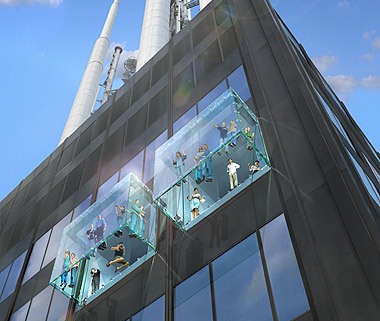

Naturally, such a structure attracts thrillseekers of a different kind as well. In 2009, the same year as the building’s name change, the Skydeck underwent renovation to now include glass boxes that jut four feet out over the skyline, informally dubbed “The Ledge.” Thrill-seeking visitors experience the sensation of floating above the city skyline while enjoying the famous view – a view which draws in 1.9 million visitors annually. Located on the 103rd floor and standing at an elevation of 1,353 feet, visitors (on a clear day) can see as far as Indiana, Michigan and Wisconsin as they feel the building sway in the wind. The building’s world-renowned observation deck, the Skydeck, has been open since 1974. Having held the title of the world’s tallest building until being unseated from the throne in 1998, Willis Tower naturally had to welcome visitors to come witness the outstanding views. Looking down from The Ledge at Willis Tower Though Sears and Roebuck Company sold the tower and moved out eighteen years later, the newly-named Willis Tower continues to host companies such as United Airlines (its largest tenant) and its new namesake, Willis Towers Watson. This soaring frame was made possible by a steel-framed bundled-tube construction, and boasts being the first building to use this structurally efficient and economic method.

Groundbreaking on the superstructure occurred a year later in 1970, and when the tower was completed three years later, it stood proud and tall at 108-stories as the world’s tallest building (surpassing even the World Trade Center in New York City). Needing a place to house their 350,000 employees, the leading retailer commissioned architectural firm Skidmore, Owings and Merrill to complete the task.Īnd complete the task they did. The tower was first envisioned in 1969 by the department store and its original namesake, Sears and Roebuck Company. One of the most contentious debates among Chicagoans this millennium has been whether they’ll call Willis Tower by its new name – or stick to tradition and refer to it as the Sears Tower. But how much do you really know about the famed Willis Tower? Today, we take a closer look at the building’s rich history. This goliath skyscraper towers over the skyline, standing as a landmark beacon from vantage points even miles away. If you stop by, you’ll find the Wrigley Building across the street!Įnjoy Spectacular Chicago Views at the Willis Tower Skydeck!ĭon’t hesitate to contact us if you’d like to know more about iconic Chicago skyscrapers.If you ask anyone – Chicago native or tourist – to name one building in the city, odds are they’ll say Willis Tower (or perhaps Sears Tower, since the name only recently changed). The Tribune Tower was completed in 1925, and stands 462 feet. The winning Gothic Revival design by Hood and Howells borrows Art Deco design ideas, and echoes elements of medieval European architecture and 13th-century French cathedrals. In 1922, the Chicago Tribune placed an ad for a building design competition - and $50,000 in prize money for the winner.

According to local lore, the design is based on a dark green champagne bottle with gold foil at the top.Įven at a modest 503 feet, you’ll get a clear view of the 37-story Carbon and Carbide Building from Michigan Avenue! While you’re in the area, don’t miss other historic Burnham-designed buildings like the Reliance Building, the Rookery Building, and Monadnock Building. The Burnham Brothers designed this landmark 1929 Art Deco skyscraper - one of Chicago’s most recognizable with its polished black granite and dark green terra cotta, and gold leaf details. After viewing this 1,054-foot giant, stop by the nearby historic Water Tower Place or the Museum of Contemporary Art.

Also known by its address of 875 North Michigan Avenue, the Hancock tops out at 100 stories and employs X-bracing on the building’s exterior to resist wind loads without interior support columns, significantly increasing the available floor space. Just before building the Willis Tower, architect Bruce Graham worked with structural engineer Khan to complete the John Hancock Center in 1970. Architect William LeBaron Jenney’s new construction technique became known as the “Chicago Skeleton,” and went on to be used in the tallest skyscrapers around the world. That’s not necessarily due to its 10-story, 138-foot height, but because it was the first design to incorporate a steel frame to support the entire weight of the building. Not only was it the first skyscraper in Chicago, but it’s also known as the world’s first skyscraper. The Home Insurance Building was completed in 1885 during the building boom that followed the Great Chicago Fire.


 0 kommentar(er)
0 kommentar(er)
